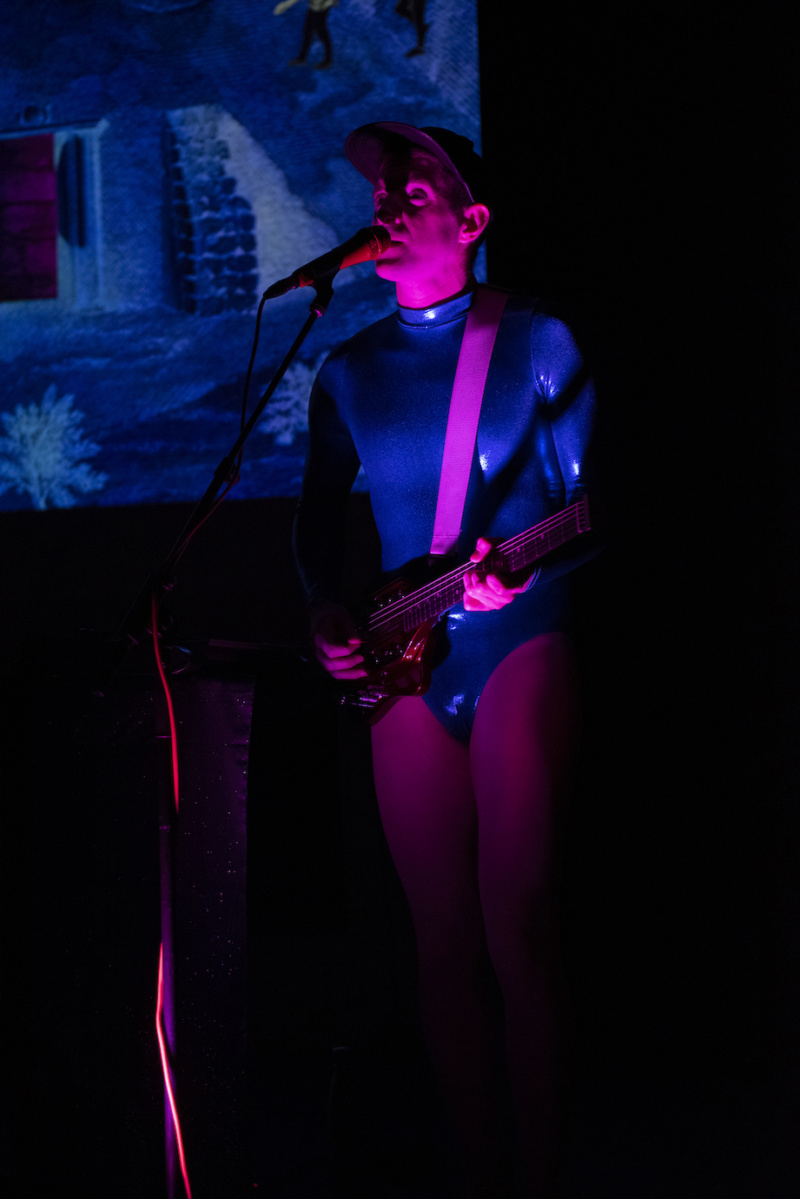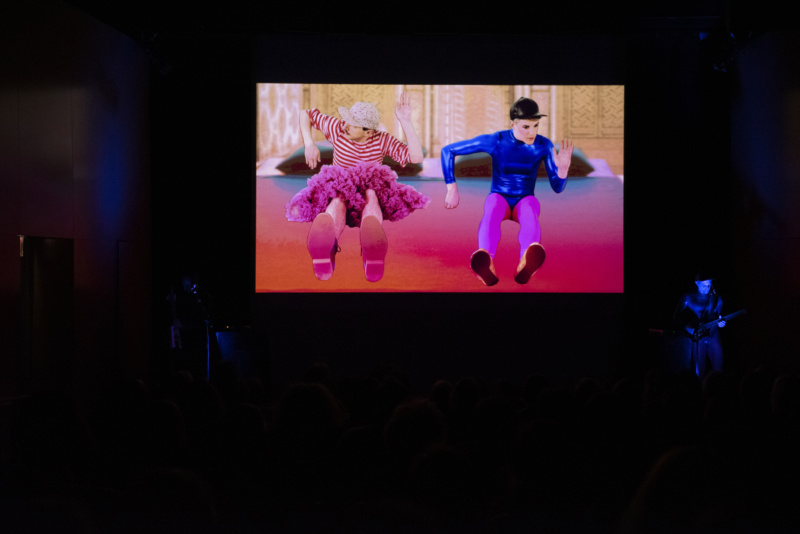
Andy Warhol Museum curator Jose Diaz interviews Alexis Gideon and Michael O’Neill of the performance art duo Princess during their 40-city tour (and counting) across America. Out There, the live narrative of their video album of original music, explores issues of gender and identity through a combination of music, video and a dash of outer space.
The performance will hit venues from the MIT List Visual Art Center in Cambridge to Milwaukee’s Cactus Club to five different 21c Museum Hotels, and debuted at the Warhol earlier this month.
Jose Diaz: Can you tell us how you first met and the origins of Princess?
Michael O’Neill: We first met in our college years through our mutual friend, artist Andy Meerow. I went to Hampshire College and Alexis went to Wesleyan. We had an instant friendship and discovered a musical bond, so we began working together making really weird music. We often booked shows at one of the two schools, improvising performances based on a single conceptual idea. One show that comes to mind is a performance based on the TV series Saved By The Bell. Another time we entered a Battle of the Bands competition as a band called “Battle of the Bands.” We did five costume changes to match five different band genres.
I remember all the fake bands: Kiwi Smoothie, Goner, The Alabamee, Sonical Foundation, and DJ Scribble Scrabble. Kiwi Smoothie was bossa nova easy listening, Goner was acid rock, and it just radiated out from there. After school we moved to Chicago in 2003 to live and work in the DIY art space Texas Ballroom. The next logical step was a genre-defying crossdressing art band called Princess. Obviously.
I really enjoy the style and delivery of your music. It feels electronic with elements of rap, rock, and pop. Can you describe your influences and sound?
Alexis Gideon: Princess’ influences are extremely varied: art-rock, hip-hop, modern classical and everything in between. We’ve always felt the boundaries between different types of musical styles are kind of absurd, but fun to play with.
MO: My earliest memories are listening to the doo-wop and Motown my father loved. At the same time, my older brother and cousin were trying to get me to listen to as much heavy metal and hard rock as they could. And I took jazz dance classes, which started my obsession with ’80s and ’90s dance music. Once Nirvana came into the picture, I fell in love with alternative rock music and would lock myself in my bedroom, figuring out how to play every song that would come on the radio.
AG: I grew up in a house that only played classical music. When I was nine I fell in love with Queen. I started studying jazz very seriously when I was 13, just before getting into LaGuardia High School of Music & Art and Performing Arts. It was New York City in the ’90s, so hip-hop was everywhere and what I listened to obsessively. I went to Wesleyan in large part because Anthony Braxton taught there. I couldn’t believe I got to study avant-garde jazz with a legend. He became my mentor and encouraged me to experiment with trans-stylistic compositions.

Is this a concept album? Please describe.
MO: Yes, definitely! We initially set out to create a more traditional record, but the piece revealed itself to us as a concept video album. We started working on this project just after the 2016 election. We both went to the Women’s March in Washington, DC and came back from it so inspired and moved, bearing witness to something so culturally important.
AG: I’d say three quarters through recording the music, we realized the piece wanted to be a narrative video concept album and performance. The music we had been making was subconsciously telling a story fueled by the political and cultural events around us. We decided to make the last quarter of the music tie the narrative themes together, and then started creating the video. The narrative follows a fictitious version of Princess, two white male “superheroes,” setting out on a mission to save the Earth from its misogynist reality.
MO: It was really important to us to show how men can receive the Divine Feminine. Princess realizes that instead of attempting to bring about outward changes to society they, as men, need to bring inward change within the themselves.
Does the music inspire the fashion choices and the video aesthetics of Princess?
AG: For sure. Our sensibilities definitely roll over into our visual aesthetic. We’ve always questioned concepts of masculinity and explored queerness in our art. Since we started Princess 15 years ago, we have been wearing clothes more traditionally worn by women. I do think there is something similarly provocative, colorful, and dynamic about the imagery in the video. We’re the opposite of beige.
If I am not mistaken, Princess is from the future in a galaxy far away exploring gender and sexuality in uncertain times. Why have they come back to Earth for this tour? What are you trying to tell us?
AG: To create Out There, we used archival public domain photos. We thought it was a good way to illustrate a story set in the future. Those old photos capture the unrest of the present. They show a continuum of dysfunction and oppression. Misogyny is as old as civilization itself and doesn’t seem to be going away any time soon.
MO: We need to utilize our privilege to amplify feminism. We need to change these patterns of our own behavior, for the men around us, and the next generation.

Andy Warhol was involved in music, from managing the Velvet Underground to directing music videos for The Cars and Curiosity Killed the Cat. Is there anything about Andy Warhol and his love of music that you thought about in preparation for the world tour, and starting off in Pittsburgh?
AG: We really connect with Warhol’s vivid and highly saturated color palette, and feel that the aesthetic of Out There is in direct conversation with it. Warhol’s love of creating something campy and humorous while still raising serious issues is another point of convergence for us.
Favorite thing in pop culture at the moment?
MO: We love TEEN! They are the trio of sisters and their vocals represent the Divine Feminine in Out There. Their new album Good Fruit was released on the same day of our world premiere at the Warhol. We’ve also been really excited to see the renewed interest in Freddie Mercury and Queen in pop culture. The name Princess came in part from our deep love of this band, which was essentially a four-person bromance queer band with one gay person in it. More on the fringe is Coley Mixan, a multi-instrumentalist and artist from Seattle whose Instagram @astro.ooze is a constant joy.
You have been in conversation with the Warhol Museum’s curatorial team for a couple of years now, and with various ideas. When did you feel you had the perfect proposal for us? Did the museum team inspire or help you?
AG: The Warhol Museum’s curatorial team was one of the earliest advocates for this piece. The Warhol team has been really generous in helping me develop my solo work. Out There was the perfect proposal for the museum. The Warhol legacy laid the groundwork for us in a way. Warhol gave the general public some language to question gender expectations and showed us the power of pop.
What can we expect from Princess once the tour is over?
MO: We’ve already started working on a new project. It’s a very novel form, which is top secret. We will keep performing Out There nationally and internationally. The response has been amazing and so nourishing. We’re grateful. We’ll be starting to work on a new concept video album performance piece by the end of the year. We’re tossing around some thematic ideas—and we’re open to suggestions.
Princess | Out There | Excerpt from Cultured Magazine on Vimeo.










 in your life?
in your life?

